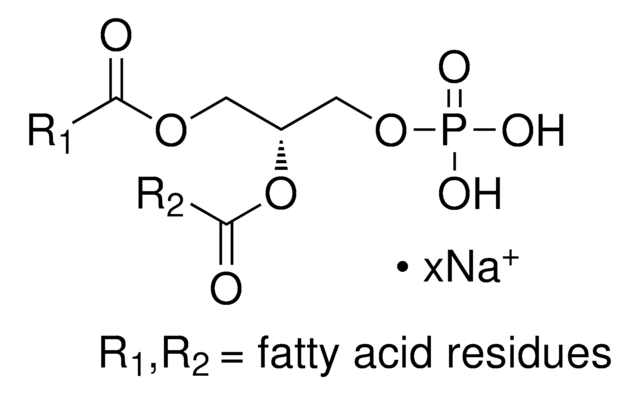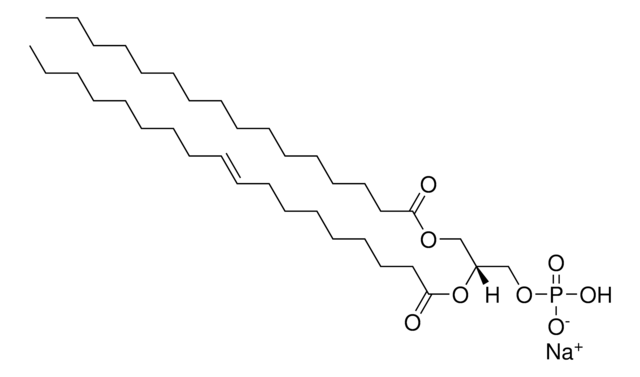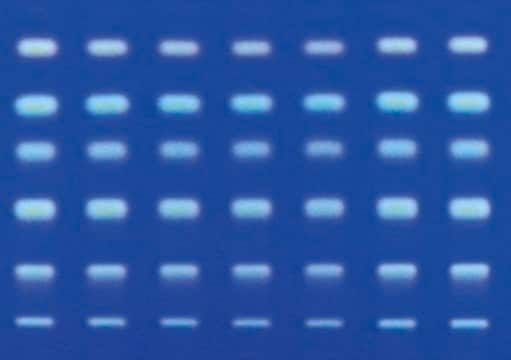857130C
Avanti
18:1 Lyso PA
1-oleoyl-2-hydroxy-sn-glycero-3-phosphate (sodium salt), chloroform
Synonym(s):
oleoyl lysophosphatidic acid; 1-(9Z-octadecenoyl)-sn-glycero-3-phosphate (sodium salt); PA(18:1(9Z)/0:0); 18:1 LPA; o-LPA; 110681
About This Item
Recommended Products
Assay
>99% (LPA; may contain up to 10% of the 2-LPA isomer, TLC)
form
liquid
packaging
pkg of 1 × 2.5 mL (857130C-25mg)
pkg of 2 × 4 mL (857130C-200mg)
manufacturer/tradename
Avanti Research™ - A Croda Brand 857130C
concentration
10 mg/mL (857130C-25mg)
25 mg/mL (857130C-200mg)
lipid type
cardiolipins
phospholipids
shipped in
dry ice
storage temp.
−20°C
SMILES string
[Na+].[P](=O)([O-])(OC[C@H](O)COC(=O)CCCCCCC\C=C/CCCCCCCC)O
InChI
1S/C21H41O7P.Na/c1-2-3-4-5-6-7-8-9-10-11-12-13-14-15-16-17-21(23)27-18-20(22)19-28-29(24,25)26;/h9-10,20,22H,2-8,11-19H2,1H3,(H2,24,25,26);/q;+1/p-1/b10-9-;/t20-;/m1./s1
InChI key
XGRLSUFHELJJAB-JGSYTFBMSA-M
General description
Application
- for liposome preparations
- to study its apoptotic effect in HeLa cells
- to determine the extraction recovery of LPA at neutral pH and acidic pH by chromatography
- to use as a LPA agonist supplement in oocytes maturation medium to study its effects during in vitro maturation of bovine cumulus–oocyte complexes
Biochem/physiol Actions
Packaging
Legal Information
Signal Word
Danger
Hazard Statements
Precautionary Statements
Hazard Classifications
Acute Tox. 3 Inhalation - Acute Tox. 4 Oral - Aquatic Chronic 3 - Carc. 2 - Eye Irrit. 2 - Repr. 2 - Skin Irrit. 2 - STOT RE 1 - STOT SE 3
Target Organs
Central nervous system, Liver,Kidney
Storage Class Code
6.1D - Non-combustible acute toxic Cat.3 / toxic hazardous materials or hazardous materials causing chronic effects
WGK
WGK 3
Flash Point(F)
does not flash
Flash Point(C)
does not flash
Choose from one of the most recent versions:
Certificates of Analysis (COA)
It looks like we've run into a problem, but you can still download Certificates of Analysis from our Documents section.
If you need assistance, please contact Customer Support.
Already Own This Product?
Find documentation for the products that you have recently purchased in the Document Library.
Customers Also Viewed
Our team of scientists has experience in all areas of research including Life Science, Material Science, Chemical Synthesis, Chromatography, Analytical and many others.
Contact Technical Service













